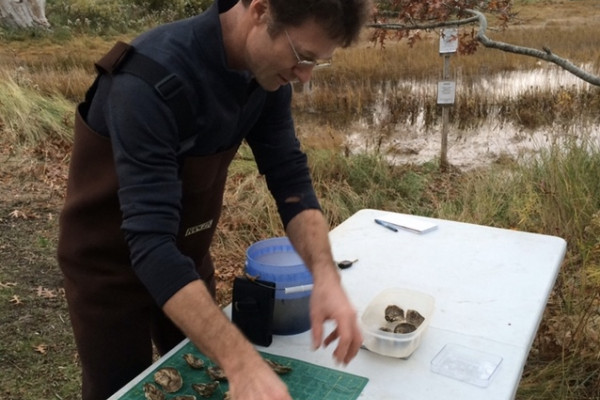
Eric Karplus shared results of using aquaculture to remove nitrogen in Lonnie’s Pond in Orleans.
Hundreds of people packed into the Boston Park Plaza Hotel’s Grand Ballroom on a frigid morning in early January to learn more about aquaculture. There would have been several dozen more, but government scientists were missing, not allowed to attend because of the partial federal shutdown. The Northeast Aquaculture Conference and Exposition draws everyone from growers of shellfish, seaweed, and finfish to town constables, researchers, gear and seed suppliers, seafood wholesalers, and shellfish advocates.
Our own shellfish maven, Mel Sanderson, was in attendance to be our eyes and ears, although given that five simultaneous presentations were ongoing, she could only scratch the surface (an apt term for a shellfish biennial conference). You can read summaries of all the presentations online.
By Melissa Sanderson
At the University of Maine Machias, Brian Beal is trying to grow razor clams. These high-value, fast-moving clams need to burrow in sand and are notoriously difficult to contain in traditional aquaculture gear. But he’s had some luck building wooden frames wrapped in screening and filled with playbox sand. He adds razor clam seed to the boxes and places them on shellfish farms and is finding better survival in intertidal areas. While his boxes may not be scalable for farming razors, his results could help protect juvenile razor clams from predators during that critical time when razor clams are part of the intertidal lunch buffet. Beal has used a similar box to collect wild steamer spat, protecting the tiny softshell clams from predators and tides, helping recruit clams to a specific area.
The Cape’s own Dan Ward of Ward Aqua Farms in Falmouth (featured in last month’s issue) has been experimenting with growing bay scallops since 2014. Bay scallops are more fussy than your typical oyster or quahog, more like growing finfish. Baby bay scallops die if you let them get too warm, too cold, or too dry. Ward’s research looked at different gear types and growing sites across Cape Cod to determine what variables promote the highest survival and growth rates. His results show that they grow best in subtidal, low-wave waters in lantern nets. More details are available online. If your town is looking for bay scallop seed for propagation or restoration, have them contact Ward!
Two talks on ocean acidification were especially interesting. Amalia Harrington at University of Maine Orono is studying the effects of warming waters and increasing ocean acidification on lobsters. She goes beyond basic concerns about shell building to look at metabolic impacts and physiological challenges. While acidification alone had little impact, when combined with warming waters the lobsters had reduced cardiac performance. Jennie Rheuban from Woods Hole Oceanographic Institute modelled 256 different scenarios for the sea scallop industry, based on water temperature, acidification levels, management and policy changes, and economic variables. Rheban reports that “under a business-as-usual scenario, sea scallop biomass may decline more than 50 percent by the end of the century,” but catch limits and additional closures could slow the decline. She believes the high value of the scallop fishery warrants additional research on acidification and warming.
Former Alliance staff member Azure Cygler (Westwood while working with us) reported on Rhode Island Sea Grant’s “come clam with me” classes to increase public awareness of shellfish and promote ecotourism. A range of educational activities, including farm tours, webinars, and video shorts are part of the Rhode Island Shellfish Initiative, helping the state work through user conflicts and market Rhode Island shellfish.
Closer to home, Eric Karplus shared results of using aquaculture to remove nitrogen in Lonnie’s Pond in Orleans. This three-year study developed gear to support high densities of oysters, measuring their nitrogen uptake in their first and second seasons of growth. The research showed increased nitrogen removal with higher stocking densities of oysters, harvesting at a smaller size. His sampling results were part of a larger study conducted by the University of Massachusetts School for Marine Science and Technology (SMAST). Using shellfish to clean our coastal waters is a hot topic. We’ve heard concerns from the shellfish industry that nitrogen mitigation oysters, which must be harvested to remove their shells (and therefore nitrogen) from the estuary, could cause an oversupply and negatively impact markets.
Growing kelp and other seaweeds also is a hot topic, with dozens of presentations including specialized gear, monitoring with underwater vehicles, impacts on nitrogen and acidification, and post-harvest processing. There were also many talks about how to properly set up large offshore farms to minimize impacts on whales and other protected species.
